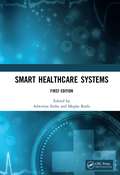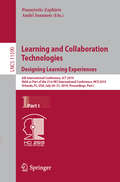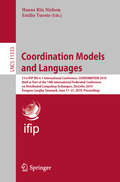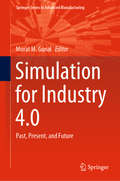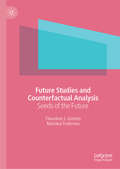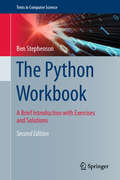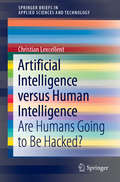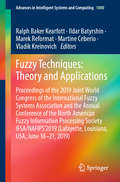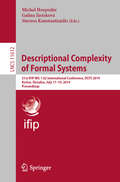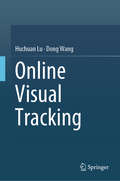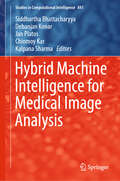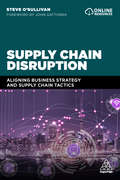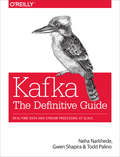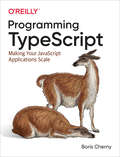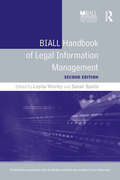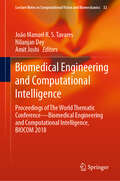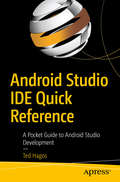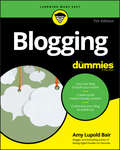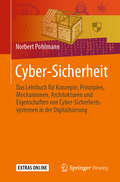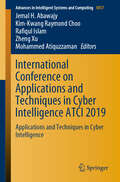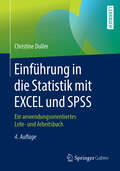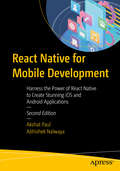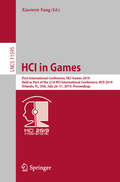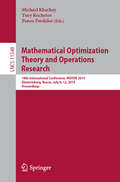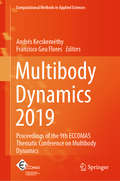- Table View
- List View
Smart Healthcare Systems
by Adwitiya Sinha Megha RathiAbout the Book The book provides details of applying intelligent mining techniques for extracting and pre-processing medical data from various sources, for application-based healthcare research. Moreover, different datasets are used, thereby exploring real-world case studies related to medical informatics. This book would provide insight to the learners about Machine Learning, Data Analytics, and Sustainable Computing. Salient Features of the Book Exhaustive coverage of Data Analysis using R Real-life healthcare models for: Visually Impaired Disease Diagnosis and Treatment options Applications of Big Data and Deep Learning in Healthcare Drug Discovery Complete guide to learn the knowledge discovery process, build versatile real life healthcare applications Compare and analyze recent healthcare technologies and trends Target Audience This book is mainly targeted at researchers, undergraduate, postgraduate students, academicians, and scholars working in the area of data science and its application to health sciences. Also, the book is beneficial for engineers who are engaged in developing actual healthcare solutions.
Learning and Collaboration Technologies. Designing Learning Experiences: 6th International Conference, LCT 2019, Held as Part of the 21st HCI International Conference, HCII 2019, Orlando, FL, USA, July 26–31, 2019, Proceedings, Part I (Lecture Notes in Computer Science #11590)
by Panayiotis Zaphiris Andri IoannouThis two-volume set LNCS 11590 and 11591 constitutes the refereed proceedings of the 6th International Conference on Learning and Collaboration Technologies, LCT 2019, held as part of the 21st International Conference on Human-Computer Interaction, HCII 2019, in Orlando, FL, USA in July 2019. The 1274 full papers and 209 posters presented at the HCII 2019 conferences were carefully reviewed and selected from 5029 submissions. The papers cover the entire field of human-computer interaction, addressing major advances in knowledge and effective use of computers in a variety of applications areas. The papers in this volume are organized in the following topical sections: designing and evaluating learning experiences; theoretical and pedagogical approaches in technology-enhanced learning; cognitive and psychological issues in learning; and technology in STEM education.
Coordination Models and Languages: 21st IFIP WG 6.1 International Conference, COORDINATION 2019, Held as Part of the 14th International Federated Conference on Distributed Computing Techniques, DisCoTec 2019, Kongens Lyngby, Denmark, June 17–21, 2019, Proceedings (Lecture Notes in Computer Science #11533)
by Hanne Riis Nielson Emilio TuostoThis book constitutes the proceedings of the 21th International Conference on Coordination Models and Languages, COORDINATION 2019, held in Kongens Lyngby, Denmark, in June 2019, as part of the 14th International Federated Conference on Distributed Computing Techniques, DisCoTec 2019. The 15 full papers included in this volume were carefully reviewed and selected from 25 submissions. The papers are organized in topical sections named: computational models; tools; exploring new frontiers; and coordination patterns.
Simulation for Industry 4.0: Past, Present, and Future (Springer Series in Advanced Manufacturing)
by Murat M. GunalThe book shows how simulation’s long history and close ties to industry since the third industrial revolution have led to its growing importance in Industry 4.0. The book emphasises the role of simulation in the new industrial revolution, and its application as a key aspect of making Industry 4.0 a reality – and thus achieving the complete digitisation of manufacturing and business. It presents various perspectives on simulation and demonstrates its applications, from augmented or virtual reality to process engineering, and from quantum computing to intelligent management. Simulation for Industry 4.0 is a guide and milestone for the simulation community, as well as those readers working to achieve the goals of Industry 4.0. The connections between simulation and Industry 4.0 drawn here will be of interest not only to beginners, but also to practitioners and researchers as a point of departure in the subject, and as a guide for new lines of study.
Future Studies and Counterfactual Analysis: Seeds of the Future
by Theodore J. Gordon Mariana TodorovaIn this volume, the authors contribute to futures research by placing the counterfactual question in the future tense. They explore the possible outcomes of future, and consider how future decisions are turning points that may produce different global outcomes. This book focuses on a dozen or so intractable issues that span politics, religion, and technology, each addressed in individual chapters. Until now, most scenarios written by futurists have been built on cause and effect narratives or depended on numerical models derived from historical relationships. In contrast, many of the scenarios written for this book are point descriptions of future discontinuities, a form allows more thought-provoking presentations. Ultimately, this book demonstrates that counterfactual thinking and point scenarios of discontinuities are new, groundbreaking tools for futurists.
The Python Workbook: A Brief Introduction with Exercises and Solutions (Texts in Computer Science)
by Ben StephensonThis student-friendly textbook encourages the development of programming skills through active practice by focusing on exercises that support hands-on learning. The Python Workbook provides a compendium of 186 exercises, spanning a variety of academic disciplines and everyday situations. Solutions to selected exercises are also provided, supported by brief annotations that explain the technique used to solve the problem, or highlight a specific point of Python syntax.This enhanced new edition has been thoroughly updated and expanded with additional exercises, along with concise introductions that outline the core concepts needed to solve them. The exercises and solutions require no prior background knowledge, beyond the material covered in a typical introductory Python programming course.Features: uses an accessible writing style and easy-to-follow structure; includes a mixture of classic exercises from the fields of computer science and mathematics, along with exercises that connect to other academic disciplines; presents the solutions to approximately half of the exercises; provides annotations alongside the solutions, which explain the approach taken to solve the problem and relevant aspects of Python syntax; offers a variety of exercises of different lengths and difficulties; contains exercises that encourage the development of programming skills using if statements, loops, basic functions, lists, dictionaries, files, and recursive functions.Undergraduate students enrolled in their first programming course and wishing to enhance their programming abilities will find the exercises and solutions provided in this book to be ideal for their needs.
Artificial Intelligence versus Human Intelligence: Are Humans Going to Be Hacked? (SpringerBriefs in Applied Sciences and Technology)
by Christian LexcellentThis book showcases the fascinating but problematic relationship between human intelligence and artificial intelligence: AI is often discussed in the media, as if bodiless intelligence could exist, without a consciousness, without an unconscious, without thoughts. Using a wealth of anecdotes, data from academic literature, and original research, this short book examines in what circumstances robots can replace humans, and demonstrates that by operating beyond direct human control, strong artificial intelligence may pose serious problems, paving the way for all manner of extrapolations, for example implanting silicon chips in the brains of a privileged caste, and exposing the significant gap still present between the proponents of "singularity" and certain philosophers. With insights from mathematics, cognitive neuroscience and philosophy, it enables readers to understand and continue this open debate on AI, which presents concrete ethical problems for which meaningful answers are still in their infancy.
Fuzzy Techniques: Proceedings of the 2019 Joint World Congress of the International Fuzzy Systems Association and the Annual Conference of the North American Fuzzy Information Processing Society IFSA/NAFIPS'2019 (Lafayette, Louisiana, USA, June 18–21, 2019) (Advances in Intelligent Systems and Computing #1000)
by Ralph Baker Kearfott Ildar Batyrshin Marek Reformat Martine Ceberio Vladik KreinovichThis book describes the latest findings related to fuzzy techniques, discussing applications in control, economics, education, humor studies, industrial engineering, linguistics, management, marketing, medicine and public health, military engineering, robotics, ship design, sports, transportation, and many other areas. It also presents recent fuzzy-related algorithms and theoretical results that can be used in other application areas. Featuring selected papers from the Joint World Congress of the International Fuzzy Systems Association (IFSA) and the Annual Conference of the North American Fuzzy Information Processing Society (NAFIPS) IFSA-NAFIPS’2019, held in Lafayette, Louisiana, USA, on June 18–21, 2019, the book is of interest to practitioners wanting to use fuzzy techniques to process imprecise expert knowledge. It is also a valuable resource for researchers wishing to extend the ideas from these papers to new application areas, for graduate students and for anyone else interested in problems involving fuzziness and uncertainty.
Descriptional Complexity of Formal Systems: 21st IFIP WG 1.02 International Conference, DCFS 2019, Košice, Slovakia, July 17–19, 2019, Proceedings (Lecture Notes in Computer Science #11612)
by Michal Hospodár Galina Jirásková Stavros KonstantinidisThis book constitutes the proceedings of the 21st International Conference on Descriptional Complexity of Format Systems, DCFS 2019, held in Košice, Slovakia, in July 2019. The 18 full papers presented in this volume were carefully reviewed and selected from 25 submissions. The book also contains 4 invited talks. They deal with all aspects of descriptional complexity and costs of description of objects in various computational models, such as Turing machines, pushdown automata, finite automata, grammars, and others.
Online Visual Tracking
by Huchuan Lu Dong WangThis book presents the state of the art in online visual tracking, including the motivations, practical algorithms, and experimental evaluations. Visual tracking remains a highly active area of research in Computer Vision and the performance under complex scenarios has substantially improved, driven by the high demand in connection with real-world applications and the recent advances in machine learning. A large variety of new algorithms have been proposed in the literature over the last two decades, with mixed success.Chapters 1 to 6 introduce readers to tracking methods based on online learning algorithms, including sparse representation, dictionary learning, hashing codes, local model, and model fusion. In Chapter 7, visual tracking is formulated as a foreground/background segmentation problem, and tracking methods based on superpixels and end-to-end deep networks are presented. In turn, Chapters 8 and 9 introduce the cutting-edge tracking methods based on correlation filter and deep learning. Chapter 10 summarizes the book and points out potential future research directions for visual tracking. The book is self-contained and suited for all researchers, professionals and postgraduate students working in the fields of computer vision, pattern recognition, and machine learning. It will help these readers grasp the insights provided by cutting-edge research, and benefit from the practical techniques available for designing effective visual tracking algorithms. Further, the source codes or results of most algorithms in the book are provided at an accompanying website.
Hybrid Machine Intelligence for Medical Image Analysis (Studies in Computational Intelligence #841)
by Siddhartha Bhattacharyya Debanjan Konar Jan Platos Chinmoy Kar Kalpana SharmaThe book discusses the impact of machine learning and computational intelligent algorithms on medical image data processing, and introduces the latest trends in machine learning technologies and computational intelligence for intelligent medical image analysis. The topics covered include automated region of interest detection of magnetic resonance images based on center of gravity; brain tumor detection through low-level features detection; automatic MRI image segmentation for brain tumor detection using the multi-level sigmoid activation function; and computer-aided detection of mammographic lesions using convolutional neural networks.
Supply Chain Disruption: Aligning Business Strategy and Supply Chain Tactics
by Steve O'SullivanDisruptive technologies have the power to upend supply chains, adding uncertainty, cost, and complexity to any business. These technologies can also create competitive advantage, but only if organizations strategically build them into their supply chains. Supply Chain Disruption, with a foreword by John Gattorna, provides the vital knowledge that supply chain managers need in order to implement disruptive technologies strategically. This essential book avoids a one-size-fits-all approach and encourages the reader to consider customer needs first before aligning appropriate technologies with each supply chain application.Supply Chain Disruption focuses on information systems, analysing how companies currently integrate and implement potentially disruptive technologies into their supply chain roadmaps. It presents new ways of planning more effectively and efficiently through the use of new tools and techniques, creating improvements in agility, customer service and cost. Online supporting resources include templates for metric-based process models focusing on the key enablers and inhibitors.
Kafka: Real-Time Data and Stream Processing at Scale
by Gwen Shapira Neha Narkhede Todd PalinoEvery enterprise application creates data, whether it’s log messages, metrics, user activity, outgoing messages, or something else. And how to move all of this data becomes nearly as important as the data itself. If you’re an application architect, developer, or production engineer new to Apache Kafka, this practical guide shows you how to use this open source streaming platform to handle real-time data feeds.Engineers from Confluent and LinkedIn who are responsible for developing Kafka explain how to deploy production Kafka clusters, write reliable event-driven microservices, and build scalable stream-processing applications with this platform. Through detailed examples, you’ll learn Kafka’s design principles, reliability guarantees, key APIs, and architecture details, including the replication protocol, the controller, and the storage layer.Understand publish-subscribe messaging and how it fits in the big data ecosystem.Explore Kafka producers and consumers for writing and reading messagesUnderstand Kafka patterns and use-case requirements to ensure reliable data deliveryGet best practices for building data pipelines and applications with KafkaManage Kafka in production, and learn to perform monitoring, tuning, and maintenance tasksLearn the most critical metrics among Kafka’s operational measurementsExplore how Kafka’s stream delivery capabilities make it a perfect source for stream processing systems
Programming TypeScript: Making Your JavaScript Applications Scale
by Boris ChernyAny programmer working with a dynamically typed language will tell you how hard it is to scale to more lines of code and more engineers. That’s why Facebook, Google, and Microsoft invented gradual static type layers for their dynamically typed JavaScript and Python code. This practical book shows you how one such type layer, TypeScript, is unique among them: it makes programming fun with its powerful static type system.If you’re a programmer with intermediate JavaScript experience, author Boris Cherny will teach you how to master the TypeScript language. You’ll understand how TypeScript can help you eliminate bugs in your code and enable you to scale your code across more engineers than you could before.In this book, you’ll:Start with the basics: Learn about TypeScript’s different types and type operators, including what they’re for and how they’re usedExplore advanced topics: Understand TypeScript’s sophisticated type system, including how to safely handle errors and build asynchronous programsDive in hands-on: Use TypeScript with your favorite frontend and backend frameworks, migrate your existing JavaScript project to TypeScript, and run your TypeScript application in production
BIALL Handbook of Legal Information Management
by Loyita WorleyThe second edition of this popular handbook has been thoroughly updated by the original team of experts and some new contributors, to provide current best practice guidance on the key legal information issues for every type of service. Each of the chapters is updated to reflect general changes in law libraries and their users in the past seven years. In particular, the handbook covers new information technologies, including social networking and communication. New chapters also focus on the key topics of outsourcing, and the impact of the 2007 Legal Services Act. The second edition of this valuable handbook continues to be an important professional reference tool for managers and staff of all types of legal information services, and will help them with the challenges they face in their work every day.
Biomedical Engineering and Computational Intelligence: Proceedings of The World Thematic Conference—Biomedical Engineering and Computational Intelligence, BIOCOM 2018 (Lecture Notes in Computational Vision and Biomechanics #32)
by João Manuel R. S. Tavares Nilanjan Dey Amit JoshiThis book reports on timely research at the interface between biomedical engineering and intelligence technologies applied to biology and healthcare. It covers cutting-edge methods applied to biomechanics and robotics, EEG time series analysis, blood glucose prediction models, among others. It includes ten chapters, which were selected upon a rigorous peer-review process and presented at the 1st World Thematic Conference - Biomedical Engineering and Computational Intelligence, BIOCOM 2018, held in London, United Kingdom, during October 30–31, 2018.
Android Studio IDE Quick Reference: A Pocket Guide to Android Studio Development
by Ted HagosThis concise reference book for Android Studio 3 presents the essential Android Studio functions in a well-organized format that can be used as a handy reference. It will quickly demonstrate the usage of the Android Studio IDE to build an Android mobile app step by step.You won’t find any technical jargon, bloated samples, drawn out history lessons, or witty stories in this book. What you will find is a reference that is concise, to the point and highly accessible. The Android Studio IDE Quick Reference is packed with useful information and is a must-have for any mobile or Android app developer or programmer.What You Will LearnDiscover the workflow basics in Android Studio 3Make tasks efficient with keyboard shortcutsCarry out unit testing in Android Studio 3Use time-saving techniques such as templatesMaster debugging basicsConfigure your project using GradleUse the profiler to monitor app performanceWho This Book Is ForThose who already know how to build applications in Android using Java. This book will serve as a handy and quick reference on how to get things done in Android Studio 3.
Blogging For Dummies
by Amy Lupold BairThe bestselling blogging book—updated in a new edition! Ready to make your mark on the online world? Start a blog! Blogging For Dummies provides you with information on blogging basics, the anatomy of a good blog, and the tools required to get started. Plus, you'll get advice on a blog topic, choosing a domain name and host, writing your first post, planning an editorial calendar, and using your blog as an important part of your personal brand. Decide which of the major blogging platforms will work for you Use SEO to drive traffic to your blog Monetization through advertising and sponsorships Create content that draws readers in Covering shifts in popular blogging platforms and tools, changes in social media, and the latest best practices in the blogosphere, this new edition sets you up for blogging success!
Cyber-Sicherheit: Das Lehrbuch für Konzepte, Prinzipien, Mechanismen, Architekturen und Eigenschaften von Cyber-Sicherheitssystemen in der Digitalisierung
by Norbert PohlmannDieses Lehrbuch gibt Ihnen einen Überblick über die Themen der IT-Sicherheit Die Digitalisierung hat Geschäftsmodelle und Verwaltungsprozesse radikal verändert. Dadurch eröffnet der digitale Wandel auf der einen Seite viele neue Möglichkeiten. Auf der anderen Seite haben Hacker jüngst mit Cyber-Angriffen für Aufsehen gesorgt. So gesehen birgt die fortschreitende Digitalisierung auch Gefahren. Für eine erfolgreiche Zukunft unserer Gesellschaft ist es daher entscheidend, eine sichere und vertrauenswürdige IT zu gestalten. Norbert Pohlmann gibt Ihnen mit diesem Lehrbuch eine umfassende Einführung in den Themenkomplex der IT-Sicherheit. Lernen Sie mehr über Mechanismen, Prinzipien, Konzepte und Eigenschaften von Cyber-Sicherheitssystemen. Der Autor vermittelt aber nicht nur theoretisches Fachwissen, sondern versetzt Sie auch in die Lage, die IT-Sicherheit aus der anwendungsorientierten Perspektive zu betrachten. Lesen Sie, auf welche Sicherheitseigenschaften es bei Cyber-Systemen ankommt. So sind Sie mit Hilfe dieses Lehrbuchs in der Lage, die Wirksamkeit von IT-Lösungen mit Blick auf deren Sicherheit zu beurteilen. Grundlegende Aspekte der Cyber-Sicherheit Im einführenden Abschnitt dieses Lehrbuchs vermittelt Ihnen Pohlmann zunächst die Grundlagen der IT-Sicherheit und schärft Ihren Blick für folgende Aspekte:StrategienMotivationenBedürfnisseProblemeHerausforderungenWirksamkeitskonzepte Tauchen Sie tiefer in die Materie ein In den darauffolgenden Kapiteln befasst sich Pohlmann mit diesen Teilbereichen der IT-SicherheitKryptographieHardware-Sicherheitsmodule zum Schutz von sicherheitsrelevanten InformationenDigitale Signatur, elektronische Zertifikate sowie PKIs und PKAsIdentifikation und AuthentifikationEnterprise Identity und Access ManagementTrusted ComputingCyber-Sicherheit Frühwarn- und LagebildsystemeFirewall-SystemeE-Mail-SicherheitBlockchain-TechnologieKünstliche Intelligenz und Cyber-SecuritySocial Web Cyber-Sicherheit Zudem erfahren Sie mehr über IPSec-Verschlüsselung, Transport Layer Security (TLS), Secure Socket Layer (SSL) sowie Sicherheitsmaßnahmen gegen DDoS-Angriffe. Anschauliche Grafiken und Tabellen bilden Prozesse und Zusammenhänge verständlich ab. Didaktisch gut aufbereitet, können Sie die Inhalte mit zahlreichen Übungsaufgaben vertiefen. Das Lehrbucht richtet sich speziell an Leser, für die die IT-Sicherheit eine besondere Rolle spielt, etwa: Studierende der InformatikAuszubildende im Bereich FachinformatikMitarbeiter und Führungspersonen der IT-Branche
International Conference on Applications and Techniques in Cyber Intelligence ATCI 2019: Applications and Techniques in Cyber Intelligence (Advances in Intelligent Systems and Computing #1017)
by Jemal H. Abawajy Kim-Kwang Raymond Choo Rafiqul Islam Zheng Xu Mohammed AtiquzzamanThis book presents innovative ideas, cutting-edge findings, and novel techniques, methods, and applications in a broad range of cybersecurity and cyberthreat intelligence areas. As our society becomes smarter, there is a corresponding need to be able to secure our cyberfuture. The approaches and findings described in this book are of interest to businesses and governments seeking to secure our data and underpin infrastructures, as well as to individual users.
Einführung in die Statistik mit EXCEL und SPSS: Ein anwendungsorientiertes Lehr- und Arbeitsbuch
by Christine DullerDieses Lehrbuch führt leicht verständlich und anwendungsorientiert in die beschreibende und schließende Statistik sowie in die Wahrscheinlichkeitsrechnung ein:Die Methoden der Statistik werden nicht nur beschrieben, sondern auch in EXCEL und SPSS umgesetzt.Zahlreiche Beispiele mit Lösungen ergänzen die Darstellung, daher ist das Buch auch für das Selbststudium gut geeignet.Wesentliche Aspekte sind übersichtlich zusammengefasst, um das Lernen zu erleichtern und ein schnelles Nachschlagen zu ermöglichen.In der vierten Auflage wurden inhaltliche Ergänzungen (Boxplots und Fisher-Test) vorgenommen und die Software-bezogenen Inhalte an die jeweils aktuellen Versionen angepasst (IBM SPSS Statistics 25, Microsoft EXCEL 2019).
React Native for Mobile Development: Harness the Power of React Native to Create Stunning iOS and Android Applications
by Akshat Paul Abhishek NalwayaDevelop native iOS and Android apps with ease using React Native. Learn by doing through an example-driven approach, and have a substantial running app at the end of each chapter. This second edition is fully updated to include ES7 (ECMAScript 7), the latest version of React Native (including Redux), and development on Android. You will start by setting up React Native and exploring the anatomy of React Native apps. You'll then move on to Redux data flow, how it differs from flux, and how you can include it in your React Native project to solve state management differently and efficiently. You will also learn how to boost your development by including popular packages developed by the React Native community that will help you write less; do more. Finally, you'll learn to how write test cases using Jest and submit your application to the App Store. React Native challenges the status quo of native iOS and Android development with revolutionary components, asynchronous execution, unique methods for touch handling, and much more. This book reveals the the path-breaking concepts of React.js and acquaints you with the React way of thinking so you can learn to create stunning user interfaces. What You'll LearnBuild stunning iOS and Android applicationsUnderstand the Redux design pattern and use it in your projectInteract with iOS and android device capabilities such as addressbook, camera, GPS and more with your appsTest and launch your application to the App StoreWho This Book Is ForAnyone with JavaScript experience who wants to build native mobile applications but dreads the thought of programming in Objective-C or Java. Developers who have experience with JavaScript but are new or not acquainted to React Native or ReactJS.
HCI in Games: First International Conference, HCI-Games 2019, Held as Part of the 21st HCI International Conference, HCII 2019, Orlando, FL, USA, July 26–31, 2019, Proceedings (Lecture Notes in Computer Science #11595)
by Xiaowen FangThis book constitutes the refereed proceedings of the First International Conference on HCI in Games, HCI-Games 2019, held in July 2019 as part of HCI International 2019 in Orlando, FL, USA. HCII 2019 received a total of 5029 submissions, of which 1275 papers and 209 posters were accepted for publication after a careful reviewing process. The 34 papers presented in this volume are organized in topical sections named: Game Design; Gaming Experience; Serious Games; and Gamification.
Mathematical Optimization Theory and Operations Research: 18th International Conference, MOTOR 2019, Ekaterinburg, Russia, July 8-12, 2019, Proceedings (Lecture Notes in Computer Science #11548)
by Michael Khachay Yury Kochetov Panos PardalosThis book constitutes the proceedings of the 18th International Conference on Mathematical Optimization Theory and Operations Research, MOTOR 2019, held in Ekaterinburg, Russia, in July 2019.The 48 full papers presented in this volume were carefully reviewed and selected from 170 submissions. MOTOR 2019 is a successor of the well-known International and All-Russian conference series, which were organized in Ural, Siberia, and the Far East for a long time. The selected papers are organized in the following topical sections: mathematical programming; bi-level optimization; integer programming; combinatorial optimization; optimal control and approximation; data mining and computational geometry; games and mathematical economics.
Multibody Dynamics 2019: Proceedings of the 9th ECCOMAS Thematic Conference on Multibody Dynamics (Computational Methods in Applied Sciences #53)
by Andrés Kecskeméthy Francisco Geu FloresIn this work, outstanding, recent developments in various disciplines, such as structural dynamics, multiphysic mechanics, computational mathematics, control theory, biomechanics, and computer science, are merged together in order to provide academicians and professionals with methods and tools for the virtual prototyping of complex mechanical systems. Each chapter of the work represents an important contribution to multibody dynamics, a discipline that plays a central role in the modelling, analysis, simulation and optimization of mechanical systems in a variety of fields and for a wide range of applications.
